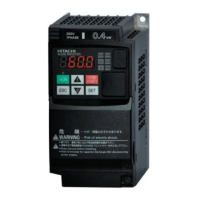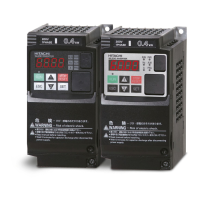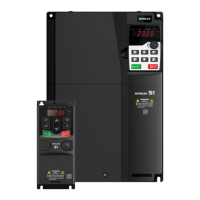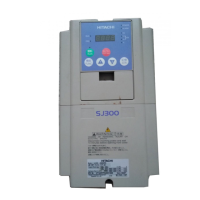Chapter 8 Mandatory Setting for Motor Drive and Test Run
8-1-9
This setting is necessary for motor protection. Set the correct value.
Even if [b012] is set to a large value, if the current grows steeply, "Overcurrent error [E01] to
[E04]" may occur before "Overload error [E05]".
Even in the case of motor/inverter common electronic thermal, "low-speed area overload
protection [E38]" occurs when overload occurs in the extremely low-speed range of 0.2 Hz or
less. Refer to "Chapter 15 Tips/FAQ/Troubleshooting" for the countermeasures to [E05]/[E38].
Trip reset is not accepted for about 10 seconds after [E05]/[E38] occur.
Change the electronic thermal characteristics
By setting "Electronic thermal characteristic selection [b013]", it is possible to set the electronic
thermal characteristic for motor/inverter common or motor according to the motor to be used. It
is possible to set the protective characteristic considering the cooling capability drop of the
motor at low speed.
Electronic
thermal
characteristics
selection
Reduced torque characteristics:
This pattern corresponds to the deterioration of the motor's
cooling capability at the low speed range.
Constant torque characteristics:
This pattern corresponds to constant torque output.
Free setting:
The pattern can be freely set the electronic thermal
characteristics according to the characteristics of the motor.
*1. "2nd-motor control [SET]" target parameter. The second control parameter is also subject
to setting.
■ Reduced torque characteristic
By setting "Electronic thermal characteristic selection [b013]" to "Reduced torque (00)", it is
possible to set the protective characteristic considering the cooling capability drop of the motor
at low speed.
The general-purpose motor (self-cooling motor) must be used with a reduced load (current)
because the cooling capability of the self-cooling fan decreases when the motor speed
decreases. (When the frequency decreases, the reduction ratio also decreases, and the thermal
level (current) also decreases.)
The reduced torque characteristics are based on the heat generated by the self-cooling motor.
The following figure (Example 1) shows an example of reduced torque characteristics when
"Electronic thermal level [b012]" is set to 9.6 A at low duty rating.
Since the reduction rate is 1.0 when the base frequency is 60 Hz, a trip occurs after 11.5 A
(120% of 9.6 A) flows continuously for 60 seconds. Since the reduction rate is 0.8 when running
at 20 Hz, a trip occurs after 9.2 A (9.6 A × 120% × 0.8) flows continuously for 60 seconds.
(Example 1) Reduced torque characteristics: 3-phase 200 V, 1. 5 kW, Low duty, Electronic
thermal level [b012] = 9.6 A
● 60 Hz reduction rate = × 1.0
● 20 Hz reduction rate = × 0.8

